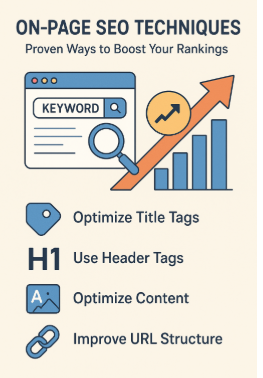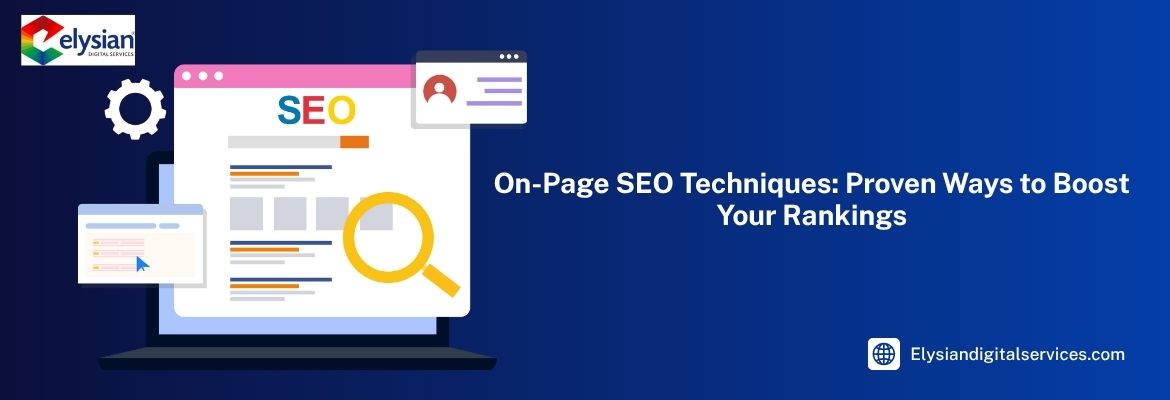In the ever-evolving digital landscape, mastering on-page SEO is crucial for enhancing your website’s visibility and driving organic traffic. Unlike off-page SEO, which involves external factors like backlinks, on-page SEO focuses on optimizing elements within your website to improve its search engine rankings.
What Is On-Page SEO?
On-page SEO refers to the practice of optimizing individual web pages to rank higher and earn more relevant traffic in search engines. It involves both the content and HTML source code of a page, including aspects like title tags, content quality, and URL structure.
Importance of On-Page SEO
Effective on-page SEO ensures that your website is accessible, relevant, and authoritative in the eyes of search engines. It helps in:
- Improving Search Engine Rankings: Well-optimized pages are more likely to rank higher in search results.
- Enhancing User Experience: A clean, well-structured website provides a better user experience.
- Increasing Organic Traffic: Higher rankings lead to more organic visitors.
- Boosting Conversion Rates: Optimized pages are more likely to convert visitors into customers.
Key On-Page SEO Techniques

1. Conduct Thorough Keyword Research
Before optimizing your pages, it’s essential to identify the right keywords. Focus on:
- Long-Tail Keywords: These are longer phrases with lower competition but higher conversion potential (e.g., “best digital marketing agency in Delhi”).
- Low-Difficulty Keywords: Target keywords with low keyword difficulty (KD) scores to increase your chances of ranking.
- High-Volume Keywords: Ensure the keywords have a significant search volume to attract more traffic.
Utilize tools like Google Keyword Planner, Ahrefs, or SEMrush to find suitable keywords.
2. Optimize Title Tags and Meta Descriptions
Title tags and meta descriptions are critical for both SEO and user experience.
- Title Tags: Include your primary keyword and keep it under 60 characters.
- Meta Descriptions: Provide a concise summary of the page content, incorporating secondary keywords, and keep it under 160 characters.
3. Create High-Quality, Engaging Content
Content is King: In the world of SEO, content marketing is king. To create content that ranks:
- Focus on User Intent: Understand what your audience is searching for and provide valuable information.
- Incorporate Keywords Naturally: Use your target keywords in headings, subheadings, and throughout the content without keyword stuffing.
- Update Content Regularly: Fresh content signals to search engines that your site is active and relevant.
4. Optimize URL Structure
A clean and descriptive URL structure helps both users and search engines.
- Keep URLs Short and Descriptive: Include primary keywords and avoid unnecessary words.
- Use Hyphens to Separate Words: This improves readability and SEO.
5. Improve Internal Linking
Internal Linking: Internal links help search engines discover more pages on your site and establish an information hierarchy.
- Link to Relevant Pages: Use descriptive anchor text to link to related content, such as our SEO services for more optimization tips.
- Avoid Overlinking: Too many links can be distracting and may dilute the value of each link
6. Optimize Images
Images enhance user experience but can slow down your website if not optimized.
- Use Descriptive File Names: Include relevant keywords in image file names.
- Add Alt Text: Describe the image content for accessibility and SEO.
- Compress Images: Reduce file sizes to improve page load speed.
7. Ensure Mobile-Friendliness
With the majority of searches now conducted on mobile devices, having a mobile-friendly website is essential.
- Responsive Design: Ensure your website adjusts to different screen sizes.
- Test Mobile Usability: Use tools like Google’s Mobile-Friendly Test to check your site’s performance on mobile devices.
8. Enhance Page Load Speed
Page speed is a ranking factor and crucial for user experience.
- Use Caching: Store parts of your site to reduce load times.
- Minimize HTTP Requests: Reduce the number of elements on your page.
- Optimize Code: Clean up HTML, CSS, and JavaScript files to improve speed.
9. Implement Structured Data (Schema Markup)
Structured data helps search engines understand the content of your pages.
- Use Schema Markup: Implement appropriate schema types (e.g., Article, Product, Review) to enhance search result listings.
- Test with Google’s Structured Data Testing Tool: Ensure your markup is correctly implemented.
10. Monitor and Analyze Performance
Regularly tracking your site’s performance helps identify areas for improvement.
- Use Google Analytics: Monitor traffic, bounce rates, and user behavior.
- Check Google Search Console: Identify crawl errors and indexing issues.
Best Practices for On-Page SEO
- Avoid Duplicate Content: Ensure each page has unique content to prevent SEO penalties.
- Use Breadcrumbs: Improve site navigation and user experience.
- Optimize for Featured Snippets: Structure content to answer common questions concisely.
- Focus on E-A-T: Establish Expertise, Authoritativeness, and Trustworthiness to improve rankings. Learn more at Elysian Digital Services for expert guidance and support.
FAQs: On-Page SEO Techniques
Q1. What is on-page SEO?
On-page SEO is the practice of optimizing elements on your website, like content, HTML tags, and URLs, to improve search engine rankings and user experience.
Q2. Why is on-page SEO important?
It helps search engines understand your website, boosts organic traffic, improves user experience, and increases the chances of higher rankings.
Q3. What are some key on-page SEO techniques?
Key techniques include keyword optimization, meta tags, high-quality content, URL structure, internal linking, mobile-friendliness, image optimization, page speed, and schema markup.
Q4. How do I choose the right keywords for on-page SEO?
Use tools like Google Keyword Planner, SEMrush, or Ahrefs to find low-competition, high-search-volume keywords that match your audience’s search intent.
Conclusion
Mastering on-page SEO is vital for improving your website’s visibility and driving organic traffic. By implementing these techniques and focusing on user experience, you can enhance your site’s performance in search engine results.
Remember, SEO is an ongoing process. Regularly update your content, monitor performance, and stay informed about SEO best practices to maintain and improve your rankings.
